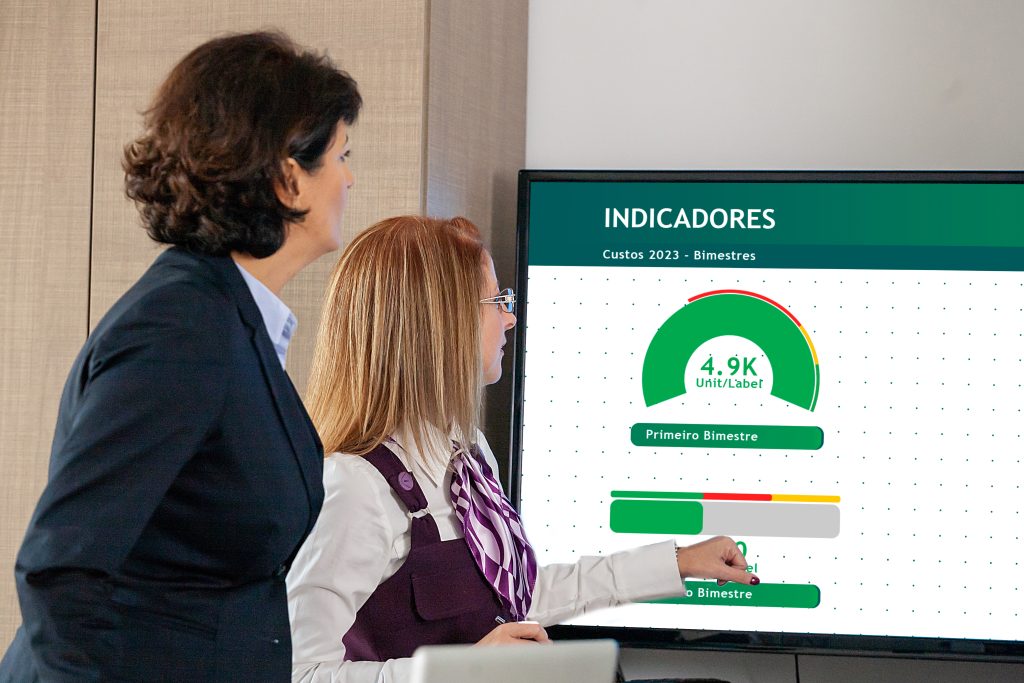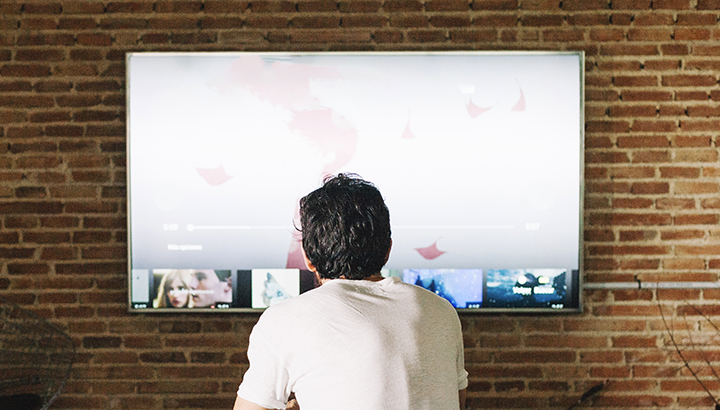Sumário
Escolher a tela “do jeito certo” não tem a ver apenas com polegadas. No ambiente corporativo — fábrica, varejo, escritórios espalhados, centros de distribuição — a decisão passa por durabilidade, brilho, garantia, segurança e pela facilidade de gestão remota. É aqui que a comparação monitor profissional vs TV deixa de ser detalhe técnico para virar impacto direto em custo total de propriedade, confiabilidade da comunicação e resultados.
Ao longo deste artigo, você vai entender as diferenças que realmente importam na prática, quando faz sentido optar por cada caminho e como integrar a escolha do display às soluções de Corporate TV It is Digital Signage da B2 Mídia — incluindo Video Wall e LED Wall, Digital Menu Board and the aplicativo de comunicação interna.
O que realmente muda no comparativo monitor profissional vs TV

Televisores residenciais são projetados para uso doméstico, com algumas horas por dia, em ambientes controlados e sem demandas de gestão centralizada. Monitores profissionais (também chamados de commercial displays or LFD – Large Format Display) são construídos para operação prolongada, com refrigeração reforçada, opções de instalação mais flexíveis, controles de segurança e firmware adequado a aplicações empresariais e de varejo. Em outras palavras: são produtos de categorias diferentes.
Um ponto que costuma definir o jogo é o ciclo de operação. Enquanto TVs de consumo geralmente são pensadas para poucas horas/dia, monitores profissionais são projetados e, sobretudo, garantidos para 16/7 ou 24/7, com suporte a longos períodos ligados sem degradação acelerada.
Além disso, há diferenças claras em garantia: fabricantes e integradores indicam que o uso comercial pode limitar ou invalidar a garantia de uma TV residencial, enquanto displays profissionais trazem cobertura de três anos e até atendimento on-site, dependendo do fornecedor. (Mediascape)
Outro ponto prático é a legibilidade. Em áreas iluminadas, vitrines, corredores e refeitórios, o brilho (em nits) and the tratamento do painel pesam no resultado.
Displays profissionais costumam oferecer brilho mais alto e estabilidade para evitar perda de contraste ao longo do dia. Isso se traduz em mensagens visíveis, menus legíveis e indicadores realmente úteis — o que, em comunicação corporativa, vale mais do que qualquer especificação isolada.
A engenharia também muda: chassi, ventilação e componentes são reforçados para suportar calor, poeira e “liga/desliga” frequente — e muitos modelos trazem recursos de segurança, bloqueio de portas e protocolos de controle (p. ex., RS-232/IP) para integração com players, sensores e sistemas.
Esses detalhes são invisíveis ao primeiro olhar, mas fazem total diferença na confiabilidade e na integração do parque. (displays2go.com)
Quando a TV residencial pode atender
Apesar das vantagens dos monitores profissionais, há contextos em que uma TV tradicional pode fazer sentido — especialmente em ambientes de baixo fluxo, uso eventual (poucas horas/dia) e iluminação controlada.
Se o objetivo é exibir conteúdo esporádico em uma sala interna, sem necessidade de operação contínua, controle centralizado ou alta luminosidade, a TV pode ser uma solução de entrada de menor investimento inicial.
Ainda assim, é essencial reconhecer as limitações: menor brilho, garantia não pensada para uso comercial e recursos de gestão mais restritos. (TVSin DigitalSignage)
Quando o monitor profissional é indispensável
Há cenários em que a alternativa correta deixa de ser “opção” e vira “requisito”:
- Operação prolongada (16/7 ou 24/7): conteúdo sempre no ar, inclusive fora do horário comercial. Ex.: áreas de produção, saguões, corredores de distribuição, QSR com Menu Board.
- Ambiente muito iluminado ou vitrine: necessidade de alto brilho e antirreflexo para manter legibilidade.
- Gestão centralizada e segurança: controle por rede, bloqueios, logs, padronização de firmware e integração com players, BI e sensores.
- Layouts especiais e rotação: orientação portrait, bezel fino para Video Wall e instalação vertical segura, conforme o manual do fabricante.
- Garantia e SLA adequados ao negócio: cobertura comercial e suporte especializado, compatível com contratos corporativos.
Custos e TCO no monitor profissional vs TV: como calcular
A comparação justa precisa ir além do preço de etiqueta. Em TCO (Total Cost of Ownership) entram:
- Vida útil sob o regime de uso real (quantas horas/dia, dias/semana);
- Consistência de brilho ao longo dos meses;
- Chamados de manutenção e deslocamento para troca;
- Garantia aplicável ao cenário de uso;
- Tempo de tela parada e impacto na comunicação (custo invisível);
- Recursos embutidos que reduzem gastos com hardware adicional (SoC, controle remoto IP/RS-232).
Na prática, negócios que exigem disponibilidade constante economizam ao longo do contrato com o monitor profissional, mesmo pagando mais no início, porque trocam menos, param menos e gerenciam melhor. Artigos e guias do mercado reforçam que, para uso de digital signage, displays comerciais tendem a durar mais e manter legibilidade, especialmente quando operam diversas horas por dia.
Integração com a sua operação: software e conteúdo contam

Tela sozinho não resolve comunicação. O que fecha a equação é a combinação hardware + software + conteúdo + operação. É aqui que as soluções da B2 Mídia encurtam caminhos:
- Software de TV Corporativa com agendamento, divisão de tela, bibliotecas de widgets, integração com Power BI e outros BIs — ideal para exibir indicadores, metas, segurança, tempo e notícias sem retrabalho da equipe. Conheça o nosso software.
- Automação e Integrações: do Digital Menu Board ao Video Wall e LED Wall, passando pelo aplicativo de comunicação interna, a proposta é publicar uma vez e reaproveitar em múltiplos canais, mantendo consistência visual e de mensagem.
- Gerenciamento remoto e métricas: publicação por grupos de telas, playlists condicionais, monitoramento de status e relatórios de exibição para avaliar alcance e fazer melhorias contínuas — um ganho enorme em operações com muitas lojas/unidades.
Essa arquitetura “fim-a-fim” reduz o atrito do dia a dia, dá escala para campanhas internas e faz a escolha do display render mais, porque o conteúdo certo chega na hora certa.
Critérios práticos de decisão entre monitor profissional vs TV
Em vez de uma lista interminável de especificações, foque no que muda o resultado no campo:
1) Horas de operação e garantia
- Precisa de 16/7 ou 24/7? Se sim, monitor profissional. TVs residenciais não são projetadas nem garantidas para essa carga. Garantias comerciais oferecem mais cobertura e aderência ao uso empresarial.
2) Brilho e legibilidade
- Ambientes claros exigem brilho elevado e tratamento antirreflexo. Esse é um diferencial recorrente dos monitores profissionais em aplicações de digital signage.
3) Gestão e segurança
- Controle por rede (IP), RS-232, bloqueios físicos/lógicos e padronização de firmware permitem escalar com menos risco e menos visitas técnicas.
4) Instalação e formatos
- Retrato/paisagem, bezel para Video Wall, VESA, ventilação e orientação recomendada pelo fabricante. Instalar “do jeito certo” preserva a vida útil e evita manchas, sobreaquecimento e desbotamento.
5) TCO e disponibilidade
- Coloque na conta o custo de troca, downtime, suporte e logística. Um display que não falha quando você mais precisa paga o investimento extra com folga.
Casos de uso: da operação contínua ao uso pontual
- Operação contínua, múltiplos turnos (indústria, logística, varejo alimentar): monitor profissional com 24/7 e gestão centralizada; combine com Corporate TV para indicadores, segurança e engajamento.
- Restaurantes e QSR: monitor profissional em Digital Menu Board por conta do brilho e da atualização frequente de cardápios e preços.
- Varejo de rua e vitrines iluminadas: monitor profissional de alto brilho para garantir legibilidade e resistência ao calor.
- Salas internas, uso esporádico: TV pode atender, desde que a operação não ultrapasse poucas horas/dia e a garantia seja compatível com o uso.
Como a B2 Mídia ajuda na decisão e no “depois” da compra
Não existe escolha isolada; existe projeto. A B2 Mídia trabalha ponta a ponta: da recomendação do display adequado ao cenário (número de horas, iluminação, instalação) à implantação e gestão com o nosso software de TV Corporativa e integrações (BI, planilhas, dashboards de RH/Operações).
- Escalabilidade de conteúdo: publique no software e leve para os monitores, para a sua TV Corporativa, para o aplicativo de comunicação interna e, quando fizer sentido, para MS Teams via integrações — mantendo a narrativa unificada.
- Padronização visual: seguimos o MIV da B2 (identidade, tipografia, cores), garantindo reconhecimento rápido da marca e consistência entre canais.
- Mensuração contínua: relatórios de engajamento e presença de tela ajudam RH e Comunicação a ajustar campanhas — assunto que se conecta a diversos temas do nosso blog de conteúdos.

Conheça a TV Corporativa B2 Mídia
Uma solução para modernizar sua comunicação interna e aumentar o engajamento da equipe.
Perguntas práticas para fechar a escolha
Antes de bater o martelo, responda com o time:
- Quantas horas por dia a tela ficará ligada? (Se a resposta beirar 16/7 or 24/7, a escolha tende ao monitor profissional.)
- O ambiente é muito iluminado? Há vitrine? (Se sim, brilho alto é essencial.)
- Vamos precisar gerenciar remotamente dezenas de telas, com logs e bloqueios? (Se sim, priorize recursos de controle e segurança.)
- Há chance de montar Video Wall ou usar retrato? (Evite improviso com TV doméstica nesses casos.)
- A garantia cobre o uso comercial pelo período que você precisa? (É comum TV residencial perder cobertura nesse cenário.)
Fechando a conta
A discussão monitor profissional vs TV não é sobre ter “o melhor do mercado”, e sim sobre ter o melhor para seu contexto.
Se a sua comunicação precisa estar visível, confiável e padronizada, especialmente em operações com muitas horas de uso e ambientes desafiadores, displays profissionais entregam mais previsibilidade e menor custo ao longo do tempo.
Se o uso é pontual e interno, uma TV pode ser o primeiro passo — desde que você reconheça as limitações e planeje a evolução.
Quer mapear seu cenário e receber uma recomendação técnica com base nas suas lojas, turnos e iluminação? Fale com a gente pelo site da B2 Media. A escolha da tela certa é só o começo; o que transforma mesmo é a combinação de tecnologia, conteúdo e operação. E nisso a gente caminhará com você.




